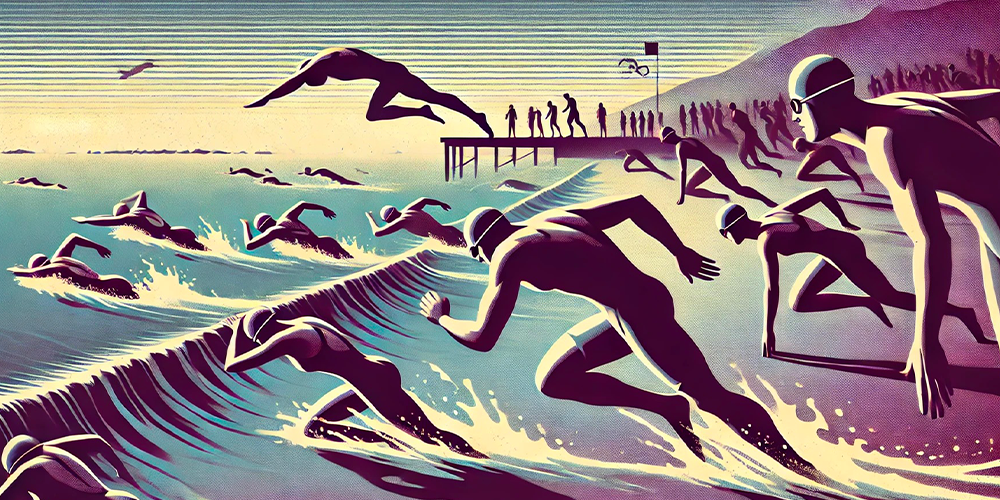With warmer weather and longer days, open water swimming season is in full swing.
Whether you’re training for a triathlon, an open water race, or simply looking for a refreshing alternative to the pool – now is the perfect time to dive in. But be aware: open water swimming is its own discipline, with unique rules and challenges. In this article, you’ll find helpful tips whether you’re a beginner or aiming to boost your race-day performance.
Just getting started? Begin here
Transitioning from the pool to a lake or the ocean can be disorienting at first: no lane lines, no walls to push off from, limited visibility… but don’t worry. With a solid foundation, it quickly becomes a natural and rewarding experience.
Here are the essential tips to start safely:
- Choose your location wisely: Swim only in authorized, supervised areas with easy access and calm water. Avoid open water with strong currents.
- Don’t swim alone: Especially when starting out, go with another swimmer or have someone accompany you on a paddleboard or kayak.
- Wear a high-visibility safety buoy: It makes you visible to boats, offers support if you get tired, and can hold small items like your keys or phone.
- Acclimate gradually: Cold water can tighten muscles and make breathing harder. Enter slowly and swim a few meters along the shore before heading farther out.
- Stay calm: If anxiety sets in, slow down, float on your back, and breathe deeply. It’s normal to feel disoriented at first. If you struggle to stay on course, a digital compass can help with orientation.
 Open Water Swimming: How to Train and Improve Effectively
Open Water Swimming: How to Train and Improve Effectively
Once you’ve gained confidence, open water swimming becomes a great training tool – but it requires a specific approach, even for seasoned pool swimmers. Here’s how to take it to the next level:
Master Sighting Without Pool Lines
In open water, you can’t rely on lane lines or the pool floor. Practice lifting your head slightly every 6–10 strokes to sight forward. A GPS watch or FORM goggles help track distance and direction in real time without stopping.
Simulate Race Conditions
If you’re training for a triathlon, get used to racing conditions: no lanes, cold starts, group swimming.
Train by starting from shore: run into the water, dive in, and start swimming immediately.
Do group starts to practice dealing with physical contact and turbulence.
Include sessions like “swim–run–swim” or short water-to-land transitions to prepare your body for changes in pace and intensity.
Targeted Pool Training
The pool remains the best place to work on:
- Endurance: steady-state swims
- Technique: body position, bilateral breathing, arm mechanics
- Speed: 100–400 m intervals with active recovery
You can then transfer this work to open water with modified distances and goals.
Open Water-Specific Drills
- Sighting: every 6–8 strokes, lift your head to fix a visual target (buoy, tree, dock)
- Race starts & drafting: start with dolphin dives, swim hard for 30–45 sec, repeat. Draft behind another swimmer to save up to 5% energy and maintain direction.
- Sprint & recovery sets: alternate 20 slow + 20 fast strokes or 30″ easy + 30″ hard to simulate overtaking and surprises
- Bilateral breathing: breathe every 2 strokes, switch sides every 50–100 m. This helps avoid sun glare, splashes, and improves sighting.
Your Gear Matters
- Wetsuit: When it comes to open water swimming in triathlon, a wetsuit is almost always a must. Choose a model that matches the average water temperature. For less experienced swimmers, the buoyancy provided by neoprene is a real advantage. It significantly improves your body position in the water, especially the position of the legs. The wetsuit should fit snugly, with no folds around the shoulders or crotch, while still allowing full freedom of movement.
- Goggles: Avoid clear lenses in bright sunlight. Opt for tinted or mirrored lenses for UV protection. FORM goggles can also display real-time data while swimming.
- Swim cap: If the water is very cold, consider wearing a neoprene cap or layering two caps for extra warmth.
- GPS & safety buoy: Use a waterproof watch to monitor distance, pace, and route. A safety buoy is essential for visibility and added safety.
Don’t Underestimate Recovery
Open water can be tougher than expected: waves, cold, orientation, stress. Always plan recovery time, stretching, sleep, and hydrate – yes, even in the water!
Checklist Before an Open Water Session
- Weather and water conditions checked
- Safety buoy packed
- Wetsuit, goggles, cap ready
- Session planned (goals, location, duration)
- Inform someone of your training location
Conclusion
Open water swimming is a rewarding adventure – not just for race prep, but for the sense of freedom and connection with nature. A triathlon swim start can’t be fully simulated, but with good planning, anything is possible. Whether you’re just starting out or chasing a new PB, the keys are preparation, safety, adaptability, and consistency.
